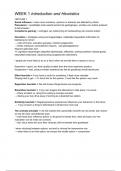WEEK 1 Introduction and Heuristics
LECTURE 1
Social influence = when one’s emotions, opinions or behavior are affected by others
Persuasion = opzettelijke actie waarbij iemand de gedragingen, emoties van andere probeert
te beïnvloeden
Compliance gaining = verkrijgen van instemming of medewerking van iemand anders
Heuristics = strategies using snel toegankelijke, makkelijke toepasbare informatie om
beslissing te nemen
→ rules of thumb, educative guesses, inituitive judgements
→ Deels onbewust, automatische respons, vast gedragspatroon
Waarom gebruiken we?
⇒ cognitieve beperkingen (beperkte tijd/energie), efficientie, werking (werken meestal goed),
rationaliteit (rationeel), waarschuwing (ongewenste uitkomsten).
! people are more likely to do us a favor when we provide them a reason to do so
Expensive = good, you think quality is better from the more expensive product
Inexpensive = bad, product minder waardevol als het als goedkoop wordt beschouwd
Effort heuristic = If you have to work for something, it feels more valuable
Playing hard to get → if I did al this for this person, I must like this person very much
Regonition heuristic = We will choose things/names we recognise
Simulation heuristic = If you can imagine the alternative to take place, it is worse
→ Plane accident vs. dying from eating a overripe avocado
→ Seeing your bus drive away of arriving at a deserted bus station
Similarity heuristic = Negative/positive experiences influences your behaviour in the future
→ If you envision a thing in beforehand it will become more real
The contrast principle ⇒ als het tweede item aanzienlijk verschilt van de eerste, dan nemen
we het als meer verschillende waar.
→ beïnvloed door reference points: in dit geval het eerste item, dient als basis voor het
inschatten van de mate van contrast.
→ bijv: als je eerst een duur item verkoopt, lijkt het tweede item goedkoper
! when choosing between options, we tend to choose the inexpensive one
→ when there is an third option, we choose the middle option = compromise
,CHAPTER 1
Fixed pattern action = aangeboren gedragspatronen bij dieren, gebeurd in dezelfde omgeving
en volgorde.
Trigger feature = start van de fixed pattern action
Contolled responding = tendency to react on the basis of a thorough analysis of all the
information
Automatic processing = automatisch, eenvoudig denken
→ kan leiden tot kostbare fouten
Heuristieken = judgemental shortcuts, stereotypes to classify things according tot a few key
features and then respond without thinking.
- Meer geneigd iets te doen als er een reden wordt gegeven (zels alleen ‘because’)
- Duurder item is van betere kwaliteit
- Als een expert het zegt, moet het waar zijn
- Contrastprinciple (tweede item anders zien dan het eerste)
Judgemental shortcuts = mental shortcuts that we employ in making our everyday judgements
→ snelle oordelen vellen zonder info te doorgronden
Click, whitt responding = tendency to respond (whirr) to one piece of information (trigger
feature/click) in a situation.
Mimic = copy trigger features of other animals in an attampt to trick these animals into playing
the right behavior tapes (past bij trigger feature) at the wrong time (valse moment van feature).
CHAPTER 7
Social influence factors on compliance = reciprocation (wederkerigheid), consistency, social
proof, liking, authority, scarcity.
Single-piece-of-good-evidence approach = beslissingen maken op basis van slechts een
goed stuk bewijs.
Paralysis of analysis = when making decisions we less frequently engage in fully considered
analysis of the total situation.
Principle of social proof = we often decide to do what other people like us are doing
→ makes sense; if an action is popular in a given situation → functional/appropriate
ADDITIONAL READING CHAPTER 4 FLUENCY AND SOCIAL INFLUENCE
Fluency = moeiteloze en soepele verwerking van informatie
Fluency variables = repetition, contrasting background, rhyme
Fluency-familiarity-truth link = frequent repetition and design qualities can increase the
influence of a message beyond its effect on attention and retention
, → problem: when we encounter misleading information
→ lastig onjuiste info te bevestigen als het vaak herhaald/gepresenteerd wordt, zodat het
makkelijk te verwerken is.
The more unfamiliar, the higher the risk perception
Fluency → familiarity → risk perception
Hard to imagine → reduced likelihood
→ the more difficult it is to imagine, the less likely we think we are to engage in it
Better fluency → less effort
→ bijv bij een makkelijk lettertype denken mensen dat de opdracht makkelijker is
Mere-exposure effect = the more we see an object, the more we like it.
→ one of the best known fluency effects




